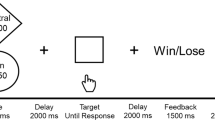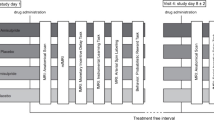Abstract
Rationale
Pramipexole, a D2/D3 dopamine receptor agonist, has been implicated in the development of impulse control disorders in patients with Parkinson's disease. Investigation of single doses of pramipexole in healthy participants in reward-based learning tasks has shown inhibition of the neural processing of reward, presumptively through stimulation of dopamine autoreceptors.
Objectives
This study aims to examine the effects of pramipexole on the neural response to the passive receipt of rewarding and aversive sight and taste stimuli.
Methods
We used functional magnetic resonance imaging to examine the neural responses to the sight and taste of pleasant (chocolate) and aversive (mouldy strawberry) stimuli in 16 healthy volunteers who received a single dose of pramipexole (0.25 mg) and placebo in a double-blind, within-subject, design.
Results
Relative to placebo, pramipexole treatment reduced blood oxygen level-dependent activation to the chocolate stimuli in the areas known to play a key role in reward, including the ventromedial prefrontal cortex, the orbitofrontal cortex, striatum, thalamus and dorsal anterior cingulate cortex. Pramipexole also reduced activation to the aversive condition in the dorsal anterior cingulate cortex. There were no effects of pramipexole on the subjective ratings of the stimuli.
Conclusions
Our results are consistent with an ability of acute, low-dose pramipexole to diminish dopamine-mediated responses to both rewarding and aversive taste stimuli, perhaps through an inhibitory action of D2/3 autoreceptors on phasic burst activity of midbrain dopamine neurones. The ability of pramipexole to inhibit aversive processing might potentiate its adverse behavioural effects and could also play a role in its proposed efficacy in treatment-resistant depression.



Similar content being viewed by others
References
Beck AT, Ward CH, Mendelson M, Mock J, Erbaugh J (1961) An inventory for measuring depression. Arch Gen Psychiatry 4:561–571
Bromberg-Martin ES, Matsumoto M, Hikosaka O (2010) Dopamine in motivational control: rewarding, aversive, and alerting. Neuron 68:815–834
Campbell-Meiklejohn D, Wakeley J, Herbert V, Cook J, Scollo P, Ray MK, Selvaraj S, Passingham RE, Cowen P, Rogers RD (2011) Serotonin and dopamine play complementary roles in gambling to recover losses. Neuropsychopharmacology 36:402–410
Chernoloz O, El Mansari M, Blier P (2009) Sustained administration of pramipexole modifies the spontaneous firing of dopamine, norepinephrine, and serotonin neurons in the rat brain. Neuropsychopharmacology 34:651–661
Collins DL, Neelin P, Peters TM, Evans AC (1994) Automatic 3D intersubject registration of MR volumetric data in standardized Talairach space. J Comput Assist Tomogr 18:192–205
de Araujo IE, Kringelbach ML, Rolls ET, Hobden P (2003a) Representation of umami taste in the human brain. J Neurophysiol 90:313–319
de Araujo IE, Kringelbach ML, Rolls ET, McGlone F (2003b) Human cortical responses to water in the mouth, and the effects of thirst. J Neurophysiol 90:1865–1876
Dooley M, Markham A (1998) Pramipexole. A review of its use in the management of early and advanced Parkinson's disease. Drugs Aging 12:495–514
Dziedzicka-Wasylewska M, Ferrari F, Johnson RD, Mierau J, Rogoz Z, Skuza G, Sokoloff P (2001) Mechanisms of action of pramipexole: effects on receptors. Reviews in Contemporary Pharmacotherapy 12:1–31
First MB, Spitzer RL, Gibbon M, Williams JBW (1997) Structured clinical interview for DSM-IV axis I disorders: clinical version. American Psychiatric Press, Washington
Friston KJ, Glaser DE, Henson RN, Kiebel S, Phillips C, Ashburner J (2002) Classical and Bayesian inference in neuroimaging: applications. Neuroimage 16:484–512
Harmer CJ, Goodwin GM, Cowen PJ (2009) Why do antidepressants take so long to work? A cognitive neuropsychological model of antidepressant drug action. Br J Psychiatry 195:102–108
Kallweit U, Khatami R, Pizza F, Mathis J, Bassetti CL (2010) Dopaminergic treatment in idiopathic restless legs syndrome: effects on subjective sleepiness. Clin Neuropharmacol 33:276–278
Matsumoto M, Hikosaka O (2009) Two types of dopamine neuron distinctly convey positive and negative motivational signals. Nature 459:837–841
McCabe C, Rolls ET (2007) Umami: a delicious flavor formed by convergence of taste and olfactory pathways in the human brain. Eur J Neurosci 25:1855–1864
McCabe C, Cowen PJ, Harmer CJ (2009) Neural representation of reward in recovered depressed patients. Psychopharmacology (Berl) 205:667–677
McCabe C, Mishor Z, Cowen PJ, Harmer CJ (2010) Diminished neural processing of aversive and rewarding stimuli during selective serotonin reuptake inhibitor treatment. Biol Psychiatry 67:439–445
McCabe C, Huber A, Harmer CJ, Cowen PJ (2011) The D2 antagonist sulpiride modulates the neural processing of both rewarding and aversive stimuli in healthy volunteers. Psychopharmacology (Berl) 217:271–278
McCabe C, Woffindale C, Harmer CJ, Cowen PJ (2012) Neural processing of reward and punishment in young people at increased familial risk of depression. Biol Psychiatry 72(7):588–594
O'Doherty J, Rolls ET, Francis S, Bowtell R, McGlone F (2001) Representation of pleasant and aversive taste in the human brain. J Neurophysiol 85:1315–1321
Oldfield RC (1971) The assessment and analysis of handedness: the Edinburgh inventory. Neuropsychologia 9:97–113
Pizzagalli DA, Evins AE, Schetter EC, Frank MJ, Pajtas PE, Santesso DL, Culhane M (2008) Single dose of a dopamine agonist impairs reinforcement learning in humans: behavioral evidence from a laboratory-based measure of reward responsiveness. Psychopharmacology (Berl) 196:221–232
Ray N, Strafella AP (2010) Dopamine, reward, and frontostriatal circuitry in impulse control disorders in Parkinson's disease: insights from functional imaging. Clin EEG Neurosci 41:87–93
Riba J, Kramer UM, Heldmann M, Richter S, Munte TF (2008) Dopamine agonist increases risk taking but blunts reward-related brain activity. PLoS One 3:e2479
Robbins TW, Everitt BJ (1996) Neurobehavioural mechanisms of reward and motivation. Curr Opin Neurobiol 6:228–236
Rolls ET, Kringelbach ML, de Araujo IE (2003) Different representations of pleasant and unpleasant odours in the human brain. Eur J Neurosci 18:695–703
Rolls ET, McCabe C (2007) Enhanced affective brain representations of chocolate in cravers vs. non-cravers. Eur J Neurosci 26:1067–1076
Santesso DL, Evins AE, Frank MJ, Schetter EC, Bogdan R, Pizzagalli DA (2009) Single dose of a dopamine agonist impairs reinforcement learning in humans: evidence from event-related potentials and computational modeling of striatal-cortical function. Hum Brain Mapp 30:1963–1976
Sokoloff P, Diaz J, Le Foll B, Guillin O, Leriche L, Bezard E, Gross C (2006) The dopamine D3 receptor: a therapeutic target for the treatment of neuropsychiatric disorders. CNS & Neurological Disorders Drug Targets 5:25–43
van Eimeren T, Ballanger B, Pellecchia G, Miyasaki JM, Lang AE, Strafella AP (2009) Dopamine agonists diminish value sensitivity of the orbitofrontal cortex: a trigger for pathological gambling in Parkinson's disease? Neuropsychopharmacology 34:2758–2766
von Zerssen D, Strian F, Schwarz D (1974) Evaluation of depressive states, especially in longitudinal studies. Modern Problems of Pharmacopsychiatry 7:189–202
Voon V, Gao J, Brezing C, Symmonds M, Ekanayake V, Fernandez H, Dolan RJ, Hallett M (2011) Dopamine agonists and risk: impulse control disorders in Parkinson's disease. Brain 134:1438–1446
Weintraub D, Koester J, Potenza MN, Siderowf AD, Stacy M, Voon V, Whetteckey J, Wunderlich GR, Lang AE (2010) Impulse control disorders in Parkinson disease: a cross-sectional study of 3090 patients. Arch Neurol 67:589–595
Wilson JL, Jenkinson M, de Araujo I, Kringelbach ML, Rolls ET, Jezzard P (2002) Fast, fully automated global and local magnetic field optimization for fMRI of the human brain. Neuroimage 17:967–976
Wise RA (2012) Dual roles of dopamine in food and drug seeking: the drive-reward paradox. Biol Psychiatry. doi:10.1016/j.biopsych.2012.09.001
Zald DH, Hagen MC, Pardo JV (2002) Neural correlates of tasting concentrated quinine and sugar solutions. J Neurophysiol 87:1068–1075
Acknowledgments
This work was funded by the Medical Research Council.
Conflict of interest
Dr. McCabe has acted as a consultant to P1Vital, Givaudan, GWpharma and the British Broadcasting Company (BBC). Professor Harmer is a company director of Oxford Psychologists and has acted as a consultant to Servier, GlaxoSmithKline, Astra Zeneca, Johnson & Johnson, Roche, Lundbeck and P1Vital. Professor Cowen is a member of an advisory board for Lundbeck. James Harwood and Sietske Brouwer report no biomedical financial interests or potential conflicts of interest.
Author information
Authors and Affiliations
Corresponding author
Electronic supplementary material
Below is the link to the electronic supplementary material.
ESM 1
(DOC 2972 kb)
Rights and permissions
About this article
Cite this article
McCabe, C., Harwood, J., Brouwer, S. et al. Effects of pramipexole on the processing of rewarding and aversive taste stimuli. Psychopharmacology 228, 283–290 (2013). https://doi.org/10.1007/s00213-013-3033-9
Received:
Accepted:
Published:
Issue Date:
DOI: https://doi.org/10.1007/s00213-013-3033-9




